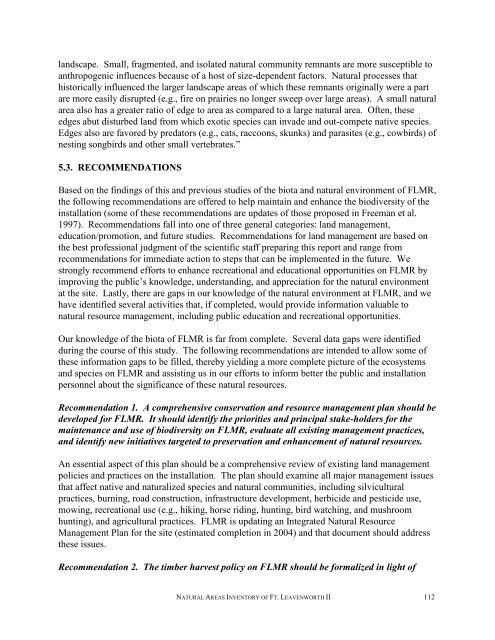A Natural Areas Inventory of the - Kansas Natural Heritage Inventory ...
A Natural Areas Inventory of the - Kansas Natural Heritage Inventory ...
A Natural Areas Inventory of the - Kansas Natural Heritage Inventory ...
You also want an ePaper? Increase the reach of your titles
YUMPU automatically turns print PDFs into web optimized ePapers that Google loves.
landscape. Small, fragmented, and isolated natural community remnants are more susceptible to<br />
anthropogenic influences because <strong>of</strong> a host <strong>of</strong> size-dependent factors. <strong>Natural</strong> processes that<br />
historically influenced <strong>the</strong> larger landscape areas <strong>of</strong> which <strong>the</strong>se remnants originally were a part<br />
are more easily disrupted (e.g., fire on prairies no longer sweep over large areas). A small natural<br />
area also has a greater ratio <strong>of</strong> edge to area as compared to a large natural area. Often, <strong>the</strong>se<br />
edges abut disturbed land from which exotic species can invade and out-compete native species.<br />
Edges also are favored by predators (e.g., cats, raccoons, skunks) and parasites (e.g., cowbirds) <strong>of</strong><br />
nesting songbirds and o<strong>the</strong>r small vertebrates.”<br />
5.3. RECOMMENDATIONS<br />
Based on <strong>the</strong> findings <strong>of</strong> this and previous studies <strong>of</strong> <strong>the</strong> biota and natural environment <strong>of</strong> FLMR,<br />
<strong>the</strong> following recommendations are <strong>of</strong>fered to help maintain and enhance <strong>the</strong> biodiversity <strong>of</strong> <strong>the</strong><br />
installation (some <strong>of</strong> <strong>the</strong>se recommendations are updates <strong>of</strong> those proposed in Freeman et al.<br />
1997). Recommendations fall into one <strong>of</strong> three general categories: land management,<br />
education/promotion, and future studies. Recommendations for land management are based on<br />
<strong>the</strong> best pr<strong>of</strong>essional judgment <strong>of</strong> <strong>the</strong> scientific staff preparing this report and range from<br />
recommendations for immediate action to steps that can be implemented in <strong>the</strong> future. We<br />
strongly recommend efforts to enhance recreational and educational opportunities on FLMR by<br />
improving <strong>the</strong> public’s knowledge, understanding, and appreciation for <strong>the</strong> natural environment<br />
at <strong>the</strong> site. Lastly, <strong>the</strong>re are gaps in our knowledge <strong>of</strong> <strong>the</strong> natural environment at FLMR, and we<br />
have identified several activities that, if completed, would provide information valuable to<br />
natural resource management, including public education and recreational opportunities.<br />
Our knowledge <strong>of</strong> <strong>the</strong> biota <strong>of</strong> FLMR is far from complete. Several data gaps were identified<br />
during <strong>the</strong> course <strong>of</strong> this study. The following recommendations are intended to allow some <strong>of</strong><br />
<strong>the</strong>se information gaps to be filled, <strong>the</strong>reby yielding a more complete picture <strong>of</strong> <strong>the</strong> ecosystems<br />
and species on FLMR and assisting us in our efforts to inform better <strong>the</strong> public and installation<br />
personnel about <strong>the</strong> significance <strong>of</strong> <strong>the</strong>se natural resources.<br />
Recommendation 1. A comprehensive conservation and resource management plan should be<br />
developed for FLMR. It should identify <strong>the</strong> priorities and principal stake-holders for <strong>the</strong><br />
maintenance and use <strong>of</strong> biodiversity on FLMR, evaluate all existing management practices,<br />
and identify new initiatives targeted to preservation and enhancement <strong>of</strong> natural resources.<br />
An essential aspect <strong>of</strong> this plan should be a comprehensive review <strong>of</strong> existing land management<br />
policies and practices on <strong>the</strong> installation. The plan should examine all major management issues<br />
that affect native and naturalized species and natural communities, including silvicultural<br />
practices, burning, road construction, infrastructure development, herbicide and pesticide use,<br />
mowing, recreational use (e.g., hiking, horse riding, hunting, bird watching, and mushroom<br />
hunting), and agricultural practices. FLMR is updating an Integrated <strong>Natural</strong> Resource<br />
Management Plan for <strong>the</strong> site (estimated completion in 2004) and that document should address<br />
<strong>the</strong>se issues.<br />
Recommendation 2. The timber harvest policy on FLMR should be formalized in light <strong>of</strong><br />
NATURAL AREAS INVENTORY OF FT. LEAVENWORTH II 112


